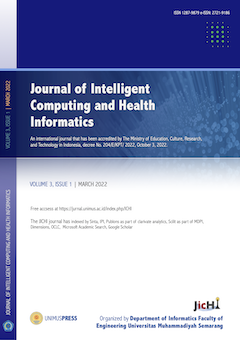The Role of EEG Signals: SVM Classification of Cognitive Load as a Support for UX Evaluation
(1) Universitas Ahmad Dahlan
(2) Universitas Ahmad Dahlan
(*) Corresponding Author
Abstract
Keywords
Full Text:
PDFReferences
or emotion analysis; Using physiological signals. IEEE Transactions on Affective Computing, 3(1), 18–31. https://doi.org/10.1109/T-AFFC.2011.15
Arjon Turnip. (2016). Kontribusi Aplikasi EEG Untuk Dunia Kesehatan | Lembaga Ilmu Pengetahuan Indonesia. http://lipi.go.id/berita/single/Kontribusi-Aplikasi-EEG-Untuk-Dunia-Kesehatan/12275
Koudelková, Z., & Strmiska, M. (2018). Introduction to the identification of brain waves based on their frequency. MATEC Web of Conferences, 210. https://doi.org/10.1051/MATECCONF/201821005012
Kumar, N., Kumar, J., & Kumar, J. (2022). A Comparative Study of Prototyping Methods for HCI Design Using Cognitive Load-Based Measures. Lecture Notes in Computer Science (Including Subseries Lecture Notes in Artificial Intelligence and Lecture Notes in Bioinformatics), 13516 LNCS, 43–58. https://doi.org/10.1007/978-3-031-17615-9_4/COVER
Kusumaningrum, D., Matematika, J., Matematika, F., Ilmu, D., Alam, P., & Imah, E. M. (2020). Studi Komparasi Algoritma Klasifikasi Mental Workload Berdasarkan Sinyal EEG. Jurnal Sistem Cerdas, 3(2), 133–143. https://doi.org/10.37396/JSC.V3I2.69
Mariam Nosheen;, Zahwa Sayed;, Muhammad Saad Malik;, & Muhammad Abuzar Fahiem. (2019). An evaluation model for measuring the usability of mobile office applications through user interface design metrics | Mehran University Research Journal Of Engineering & Technology. Mehran University Research Journal Of Engineering & Technology, 38(3). https://search.informit.org/doi/abs/10.3316/informit.502946865017921
Octaviani, P. A., Wilandari, Y., & Ispriyanti, D. (2014). PENERAPAN METODE KLASIFIKASI SUPPORT VECTOR MACHINE (SVM) PADA DATA AKREDITASI SEKOLAH DASAR (SD) DI KABUPATEN MAGELANG. Jurnal Gaussian, 3(4), 811–820. https://doi.org/10.14710/J.GAUSS.3.4.811-820
Samie, F., Bauer, L., & Henkel, J. (2019). From cloud down to things: An overview of machine learning in internet of things. IEEE Internet of Things Journal, 6(3), 4921–4934. https://doi.org/10.1109/JIOT.2019.2893866
Shantha Selva Kumari, R., & Prabin Jose, J. (2011). Seizure detection in EEG using time frequency analysis and SVM. 2011 International Conference on Emerging Trends in Electrical and Computer Technology, ICETECT 2011, 626–630. https://doi.org/10.1109/ICETECT.2011.5760193
Sofyan, N. A., Purnamasari, R., & Hadiyoso, S. (2019). Klasifikasi Tipe Emosi Arousal Pada Sinyal Eeg Dengan Metode Support Vector Machine. EProceedings of Engineering, 6(1). https://openlibrarypublications.telkomuniversity.ac.id/index.php/engineering/article/view/8889
Tiwari, P., & Melucci, M. (2018). Towards a quantum-inspired framework for binary classification. International Conference on Information and Knowledge Management, Proceedings, 1815–1818. https://doi.org/10.1145/3269206.3269304
Wardani, S., Darmawiguna, I. G. M., & Sugihartini, N. (2019). Usability Testing Sesuai Dengan ISO 9241-11 Pada Sistem Informasi Program Pengalaman Lapangan Universitas Pendidikan Ganesha Ditinjau Dari Pengguna Mahasiswa. Kumpulan Artikel Mahasiswa Pendidikan Teknik Informatika (KARMAPATI), 8(2), 356. https://doi.org/10.23887/KARMAPATI.V8I2.18400
Witten, I. H., Frank, E., Hall, M. A., & Pal, C. J. (2017). Extending instance-based and linear models. Data Mining, 243–284. https://doi.org/10.1016/B978-0-12-804291-5.00007-6
Yudhana, A., Mukhopadhyay, S., Karas, I. R., Azhari, A., Mardhia, M. M., Akbar, S. A., Muslim, A., & Ammatulloh, F. I. (2019). Recognizing Human Emotion patterns by applying Fast Fourier Transform based on Brainwave Features. Proceedings - 1st International Conference on Informatics, Multimedia, Cyber and Information System, ICIMCIS 2019, 249–254. https://doi.org/10.1109/ICIMCIS48181.2019.8985227
Article Metrics
Abstract view : 286 timesPDF - 34 times
DOI: https://doi.org/10.26714/jichi.v4i1.11198
Refbacks
- There are currently no refbacks.
____________________________________________________________________________
Journal of Intelligent Computing and Health Informatics (JICHI)
ISSN 2715-6923 (print) | 2721-9186 (online)
Organized by
Department of Informatics
Faculty of Engineering
Universitas Muhammadiyah Semarang
W : https://jurnal.unimus.ac.id/index.php/ICHI
E : jichi.informatika@unimus.ac.id, ahmadilham@unimus.ac.id
This work is licensed under a Creative Commons Attribution-ShareAlike 4.0 International License.









